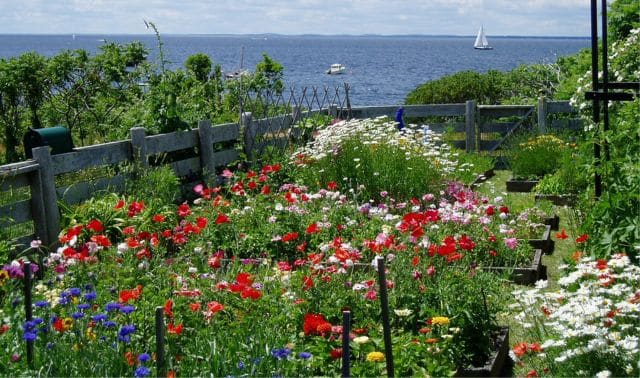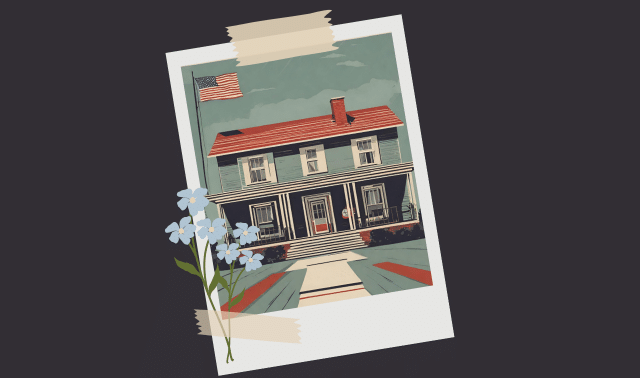Sign up for the Family Tree Newsletter Plus, you’ll receive our 10 Essential Genealogy Research Forms PDF as a special thank you!
Get Your Free Genealogy Forms
"*" indicates required fields

Over the years I have visited many private gardens and talked with lots of home gardeners. One common thread is that they all have at least one plant – and usually many more – that reminds them of a loved one. No matter who those loved ones are, their stories are kept fresh in mind by seeing those plants every day. Whether you have recently lost someone near and dear, or you simply want to memorialize an ancestor whom you admire, you can honor their memory by growing their favorite plants in a memorial garden.
If you don’t have much experience with gardening, you might feel intimidated about getting started. Fortunately, the process need not be overly difficult. Below are some tips to guide you through it all.
Healing Through the Earth
Gardening is one of the oldest healing arts. Your garden is a gift to your soul and can be a source of strength, especially in times of emotional need. The fundamental elements of earth, sun, and rain have a grounding effect. Plants keep us in touch with the eternal rhythms of germination and birth, flowering and growth, nurturing and caretaking, and trauma and loss – the timing of our own lives and the seasons.
ADVERTISEMENT
Contact with nature also plays a critical role in our psychological well-being. The garden provides comfort that can be hard to find in our busy everyday lives. Simple acts such as raking leaves and clipping back spent plants bring order to life when so much else seems out of control. Physical labor like digging or hoeing is a positive way to express frustration and relieve tension. Whether planting bulbs, picking beans, or pulling weeds, gardening can carry us into a meditative state of absolute absorption. Time passes quickly and though we may be physically tired, we frequently feel exhilarated after gardening since it is such a positive and hopeful act. By renewing the spirit, more grows in the garden than the gardener has sown.
Designing Your Memorial Garden
Every living memorial is personal and unique to your needs, desires and abilities. For this reason, there are no rules that dictate what makes the right memorial garden. Think about how you want to present your memory garden. If you are starting from scratch, you might devote it solely to plants and ornaments that hold special meaning. You might also fence it in or mark boundaries to set it apart from the rest of the landscape. An archway or arbor can formally designate the entrance.
For plantings, take stock of what you already have growing, especially things that came from a relative or conjure up fond memories, and transplant them to your new garden spot. If they are large and hard to move, propagate them by taking cuttings or dividing them. If that is not possible, leave them where they are and bring the other elements to them. Mature trees and shrubs and established perennials can give you a place to start. If you are planting a new tree, be sure to take into account its mature size and give it plenty of room. Adding annuals for season-long color will help to tie it all together. Look for locally grown, pesticide-free, native plants to make your memorial garden a safe home for pollinators.
ADVERTISEMENT
Choosing a Location
Where should you locate your memorial garden? The amount of sun the site gets should be a determining factor when choosing appropriate plants. Peak sunlight hours are between 10 a.m. and 2 p.m. When shopping for plants, consult their tags to see how much sun they require. Full sun is considered to be 6–8 hours (or more) of direct sunlight per day. Partial sun/part shade is 3–6 hours of direct sunlight per day. Light shade or dappled shade is bright sun filtered through the leaves of trees overhead. Full shade is less than 3 hours of sun. Bear in mind that if you have your heart set on a rose garden, it will need full sun. Many plants do best when they receive morning sun and afternoon shade, especially in the South where summers can be brutally hot. By grouping plants that have similar needs, your garden will be easier to tend.
Also take the microclimate into consideration: Is it a spot that warms up fast in the spring or is it a cold pocket that is the last place to thaw out? It is buffeted by strong winds or sheltered?
A few other things to consider are accessibility. Is it easy to get to? How much privacy would you like? Is it quiet enough for you to be able to sit with your thoughts without too much noise? Do you want to see the garden from inside the house? Closeness is a nice touch that keeps you connected with the garden even on inclement days.
Access to water is critical. If you have to lug heavy jugs of water on hot days, chances are the plants will get neglected. Watering is much easier if there is a hose nearby. To deliver water right to the roots of the plants where it is needed, consider installing drip irrigation. It will save you time and money in the long run and conserve water as well. Your memorial garden needs to be a pleasant spot where you enjoy spending time. It should not become another chore.
Good soil is key to any gardening success. Have yours tested to learn its make up and see what amendments are needed to enhance its fertility. Compost is always a welcome soil enhancement, but go easy on the fertilizer. The excess will be washed into local streams and lakes, polluting them. Think about growing your garden organically to protect the pollinators, birds, and other wildlife that will be drawn to it. They bring joyful life to any garden!
Creating a Memory Walk
Rather than growing your memorial garden all in one space, a memory walk is also a great way to honor ancestors and loved ones. Link plants you already have by placing other special plants and remembrances along the way for you to contemplate as you pass by. The pathway can be paved with brick, stepping stones, wood chips, or mulch. Special bricks or stepping stones can be engraved with names, dates, or meaningful quotes. You can integrate them into the walkway or just place them alongside the path.
Your contemplative walk can also take the shape of a labyrinth. Unlike a maze that has confusing dead ends and is hard to navigate, a labyrinth is simply a curved path that winds to the center of a circle. The path can be paved, outlined with stones, or simply a mowed strip of grass through taller plants. Walking it gives you time for quiet reflection. Once you reach the center, pause and reset, then follow the path back the way you came!
Selecting Your Favorite Plants
You can keep the memories of lost loved ones alive by growing some of their favorite plants. If they were gardeners, you may already have some of their plants in your yard. Every spring, I am reminded of my family when the irises blossom. The early blue ones came from my mother’s garden, the tall yellows from my sister, and the two-tone yellow and purple ones were my Nana’s. Since irises need dividing every 3-5 years, they are readily shared.
My gardens are full of pass-along plants from friends and relatives who are no longer with us which gives me plenty of chances to reminisce and retell the stories associated with each one. If you have been gardening for years, I’m sure you have many plants that tell a story too, and some that could be considered family heirlooms.
Heirloom Plants
What makes a plant an heirloom? It should be an open-pollinated variety that is at least 50 years old. Some folks also believe that it should have been passed down in one family for at least three generations, sort of like a quilt or silverware. Like any family treasure, heirloom plants have been saved and handed down for a reason. It can be ease of cultivation, reliability, beauty of the flowers, or outstanding flavor of a vegetable. People have gone to great lengths to bring their favorites from the old country with them when they emigrate. The names of many plants pay homage to their country of origin or the family who saved them. You can help keep rare plants from extinction by growing them and saving their seeds to replant or to share with friends and family. For a quick how-to, see our sidebar on seed saving. Seeds for many types of heirloom plants can be found for sale at Seed Saver’s Exchange, Baker Creek Heirloom Seeds, Select Seeds, or Southern Exposure Seed Exchange.
If you are lucky enough to have access to plants that have been passed down through the generations they will make a meaningful statement in your memorial garden. If not, don’t despair, there are plenty of other ways a plant can symbolically honor your loved ones.
Seed Saving
Once you’ve chosen the plants to collect seed from, first be sure they are open-pollinated varieties and not hybrids. Leave several fruits or seed heads on the plant to mature. With vegetables, the fruit should remain on the plant 1-2 weeks beyond the time when they would be picked for eating. They should be fully ripe but not rotten. For most flowers, the seeds are ready to harvest about a month after the blossoms fade. The best time to gather seeds is in the afternoon on a dry, sunny day. To clean the seed, shake it loose from the seed pods and try to separate as much of the debris from the seed as you can because chaff can harbor fungi or insects. Even if the seeds appear to be dry when first collected, spread them on a newspaper to dry for about a week before storing. When thoroughly dry, place the seeds in envelopes labeled with the plant’s name, harvest date, and other useful information like color, height, etc. Keep envelopes in an airtight container in a cool dry place.
Some seeds require a little more effort. Tomato seeds must be fermented in water for a few days to remove the gelatinous coating around them and to simulate the natural rotting of the fruit. Fermentation also kills many seed-borne diseases. Scoop the seeds from an overripe but not rotten tomato and place them in a bowl of water. Let it sit at room temperature for two or three days. Stir occasionally to prevent mold from forming. Once the seeds have settled to the bottom, they can be rinsed and dried. Any seeds that float should be thrown away because they will not germinate. Allow the seeds to air dry on newspaper or a fine screen for a week or two before storing them.
The Language of Flowers
In Victorian times messages were sent between lovers and friends in code using flowers with symbolic meanings. A few examples from my 1850 volume of The Language of Flowers and Their Poetic Sentiments are:
- Alyssum – worth beyond beauty
- Bee Balm – compassion
- Lavender – devotion
- Lilac – love
- Phlox – our souls are united
- Quince – lifelong fidelity
- Red tulips – undying love
- Violet – faithfulness
- Yarrow – a cure for heartache
- Zinnia – I mourn your absence
There have been many volumes written about the language of flowers and some of the meanings differ. Choose from whatever source suits your purpose – print or online.
All in a Name
The first time I saw the name “Helen Elizabeth” on a salmon-pink Oriental poppy, I knew I had to have one. Not only is the flower gorgeous but it also bears my grandmother’s name! She would have loved that! I also have a Merrill magnolia, to pay homage to my father’s family. These plants have no connection to my family other than the name so if you run across a plant bearing the name of a loved one, feel free to add it to the mix!
Some plants have common names that make them perfect symbols for a memory garden such as Forget-me-not (Myosotis), Love-in-a-mist (Nigella), or Heartsease (Viola).
Including All the Senses
My first garden memories are sensory ones. My aunts loved walking me around their mother’s overgrown garden, pointing out different things for me to taste, smell, and feel. Even though spearmint can be a runaway thug in the garden, it is a must-have for me. Just a whiff of its fragrance takes me back to days gone by. The flavor of red raspberries and the feel of a soft furry lamb’s ear also evoke memories from long ago. Don’t forget sound. A water feature or small fountain can add the calming sound of flowing water and many people find wind chimes to be a soothing way to add music to the air. Indulge all your senses when choosing items for your memory garden.
Personalize the Decor
Your memorial garden is an ideal place for garden art and decorations that hold special meaning or reflect your loved one’s personality and interests. Plaques and signage with favorite quotes, photos in weatherproof frames, engraved stones, sundials, flags, or statues are just a few examples of common tributes. At one garden I visited, the owner had a pair of her husband’s old gardening gloves bronzed and placed them in her garden as a reminder of all the hours they had worked there together (pictured below).
Even if your loved one was not a bird watcher, by all means invite the birds into your memorial garden with bird houses, feeders, and bird baths. (Find an Audubon store near you or look online.) Their songs and antics will bring life into the space and they will help with insect control by eating caterpillars and other bugs that might damage your plants. Many people believe birds bring us messages from those who have passed on. You probably have heard the old saying “When cardinals appear, angels are near.”
Comfy seating acts as a destination and is a must if you are going to spend any time in your garden. Benches and chairs can be personalized and placed where you can admire the plantings. Even on days when you don’t feel the need to work in the garden, you can venture out and sit quietly with your thoughts.
Add a table so you can have your morning coffee or enjoy a meal out there. Be sure to include lighting. Path lights, string lights, lanterns, candles, spotlights on special features, or solar lights will draw attention to the garden in the evening. If you have room, a fire pit will entice you to visit the space at night.
Plant Care All Year Long
Like any garden, your memorial garden will need some maintenance to keep it looking its best. Here are a few basic tasks by season:
Spring
- Don’t start too early. Give the soil a chance to dry out and let overwintering beneficials wake up before you begin.
- Cut back spent plants left standing and remove other debris.
- Rake carefully around tender new shoots.
- Prune damaged or crossing branches and dead rose canes.
- Divide and plant perennials.
- Plant roses, trees, and shrubs early but wait until danger of frost has passed before planting tender annuals.
Summer
- Prune spring flowering shrubs after they have finished blooming.
- Remove spent blossoms as they fade.
- Replenish mulch.
- Water during dry spells. Most plants need 1 inch of rainfall per week.
- Weed, weed, weed.
Fall
- Leave the leaves! Mow them and blow them into the flowerbeds to act as winter protection for your plants.
- Store any breakable garden ornaments that might be damaged by extreme cold.
- Remove spent annuals but let the perennials stand. Their seeds add winter interest and feed the birds.
- Plant bulbs for spring.
Don’t feel like you have to plant your memorial garden all at once. It can be a work in progress. As you find appropriate plants and other items to add, your grief will take root and grow into a celebration of life.
Related Reads
ADVERTISEMENT














